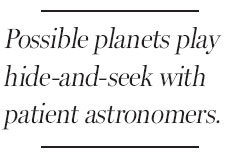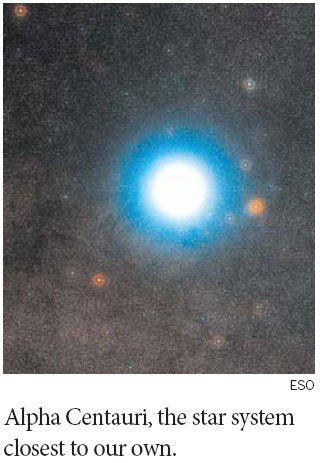Ease up on Alpha Centauri trip plans
Updated: 2013-06-23 07:52
By Dennis Overbye(The New York Times)
|
|||||||
Last autumn, European astronomers said they had found a planet with a mass like Earth's orbiting Alpha Centauri B, part of a triple star that is the Sun's nearest neighbor, only 4.4 light years away.
The new planet would be too hot for life, but where there is one planet there are likely to be others, more comfortably situated for life.
Now, however, a new analysis of the European data has given rise to doubts. Artie P. Hatzes, the director of the Thuringian State Observatory in Tautenburg, Germany, has reported that he could not confirm the planet when he studied the data. "Sometimes it is there, other times not," depending on the method he used to reduce the statistical noise, he said.
"In my years of experience in extracting planet signals, this simply does not 'smell' like a real planet," Dr. Hatzes wrote.
Suzanne Aigrain of Oxford University in England said that Dr. Hatzes' paper "certainly casts doubt on the original evidence."
Xavier Dumusque of the University of Geneva, who led the original discovery effort, acknowledged that "the signal we are searching for is at the limit of the data precision."

More data, everyone agrees, is essential. Debra Fischer, an astronomer at Yale University in Connecticut, said both her group and the Geneva team will be studying more observations obtained in May.
The Alpha Centauri B planet is not the first promising world to slip into uncertainty. Astronomers are still arguing about Gliese 581g, a "Goldilocks" planet said to be almost a sure bet for life when it was discovered in 2010.
Dr. Dumusque and his colleagues first found the planet by the "wobble" method, which measures planets' masses by how much they tug their host star.
NASA's planet-hunting Kepler satellite uses the blink method to find planets when they cross in front of their stars. But it is running up against limits of time.
Kepler's astronomers once thought they would need three years to verify the existence of planets in comfortable orbits like our own. But the stars turned out to be noisier than predicted. A year ago, Kepler's mission was extended so that more blinks could be collected, but the failure in May of a reaction wheel that allows the telescope to point precisely may have brought an end to that.
There is still an enormous amount of data supplied by Kepler, including 132 confirmed planets and 3,216 candidates.
And waiting in the wings for a 2017 launching is the Transiting Exoplanet Survey Satellite, TESS, which will monitor about two million nearby stars for exoplanets. "When starships transporting colonists first depart the solar system, they may well be headed toward a TESS-discovered planet as their new home," the project's leader, George R. Ricker of the Massachusetts Institute of Technology, has said.
It might even be in Alpha Centauri.
The New York Times

(China Daily 06/23/2013 page11)